A Digital Security Door Lock System with RFID: Enhancing Student Card (KTM) Capability for Door Unlock and Attendance Electrical Laboratorium based on IoT using NodeMCu 8266
Penelitian ini bertujuan untuk meningkatkan sistem keamanan suatu ruangan menggunakan RFID dan NodeMCu ESP8266 berbasis Internet of Thing’s sebagai media pengumpulan informasi yang dapat merekam jejak pengguna Laboratorium Teknik Elektro dengan memaksimalkan Kartu Tanda Mahasiswa sebagai akses masuk dan keluar. Sistem yang dirancang terdiri dari control circuit yang mengendalikan buka tutup pintu dengan dua lapis keamanan yaitu RFID dan Password, localhost web yang memantau, menampilkan dan merekam informasi status pengguna seperti membaca nomor kartu pengguna, nama, waktu masuk atau keluar, sehingga dapat meminimalisir kehilangan aset berharga didalam Laboratorium Teknik Elektro. Data informasi yang direkam terbagi menjadi 2 tempat penyimpan: 1). Google Spreadsheet sebagai 3rd platform IoT Clouds MQTT 2). Localhost xampp yang berada di PC Server.
Kata kunci :
Radio Frequency Identification, NodeMCu ESP8266, Internet of Thing’s, Google Spreadsheet, IoT Cloud MQTT, Localhost xampp.
0. Illustration
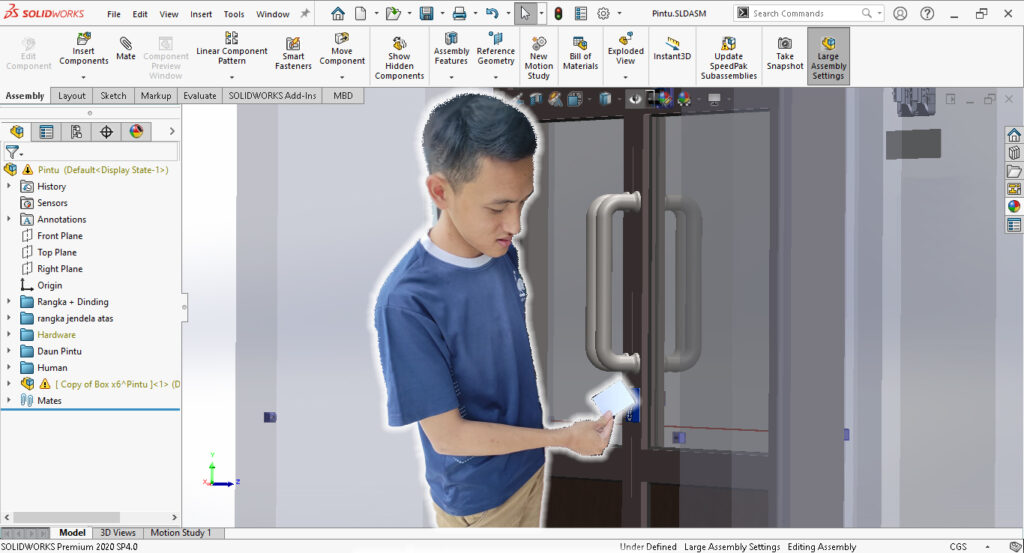
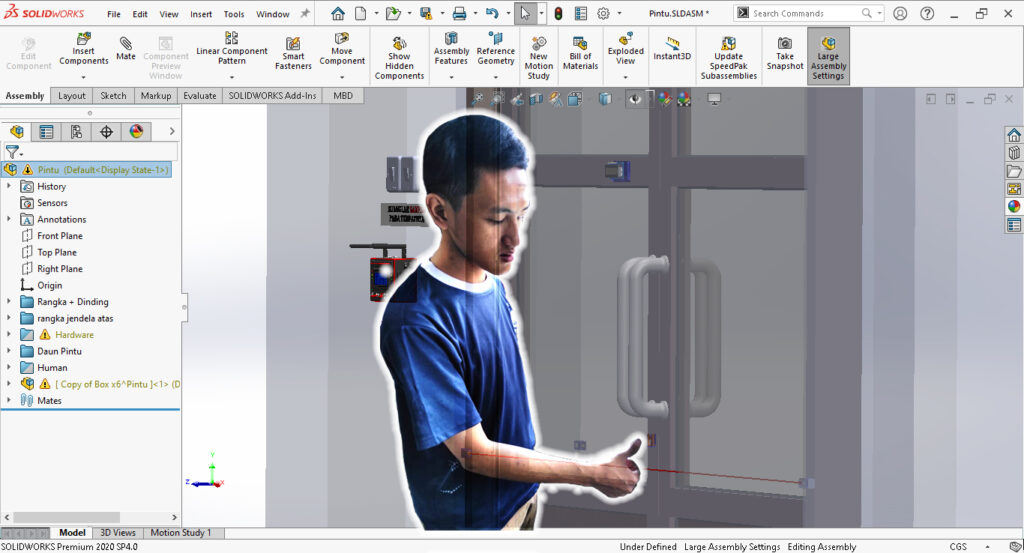
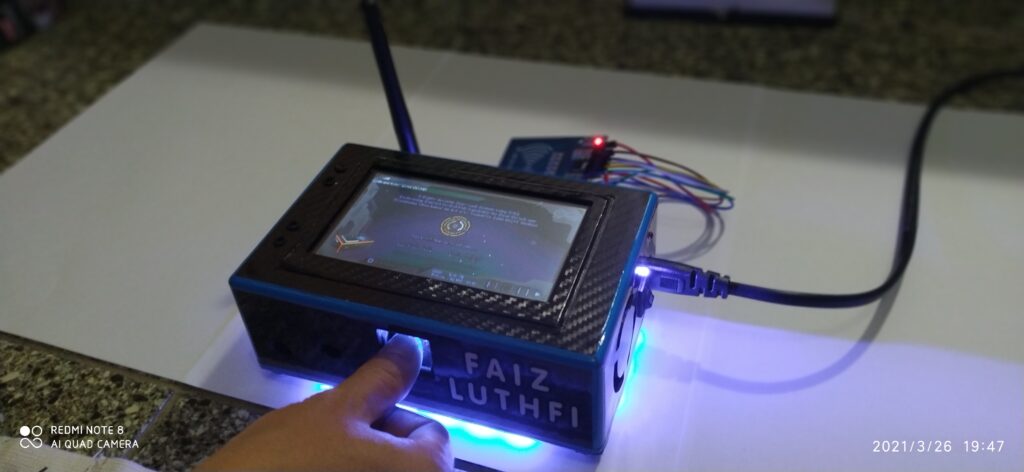
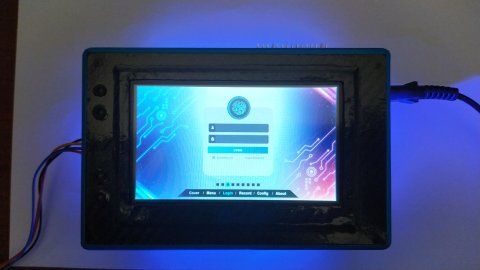
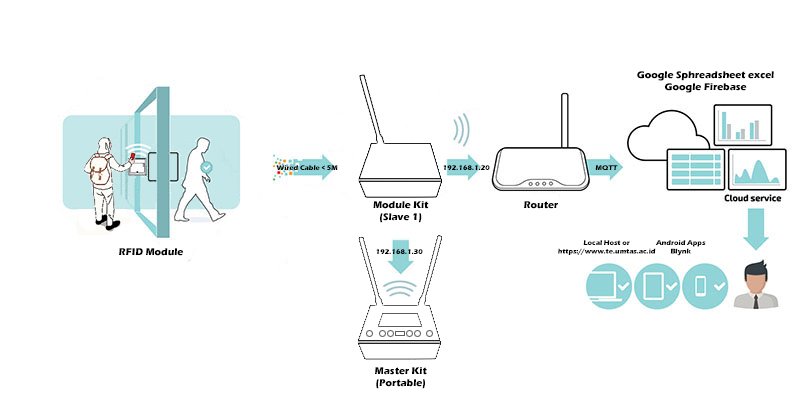
1. Dokumen
- Proposal
- Presentasi Proposal
- Design Drawing & 3D Model
2. Alat / Bahan
- Arduino IDE v.1.8.15
- Nextion Editor v1.63.3
- xampp PHP v8.0.8
- Solidworks 2020 SP2
- Fritzing
- NodeMCu ESP8266 Lolin v3
- HW-389 NodeMCU Shield for ESP8266 Lolin v3
- RFID module RC522 Kits S50 13.56Mhz
- Nextion HMI NX4827T043_11 4.3″
- Magnetic Door Lock 12v 180kg 300lbs
- Fingerprint Sensor
- TTP2238 Touch Sensor
- Box x5
- Resistor 330ohm SMD 1206
- LED 3mm + Bezzel
- DIP Switch 4pin
- Header Male 40pin
- Kabel Dupont Male to Male, Male to Female, Female to Female
- Cable Spiral
- Mini Rocker Switch
- USB to ESP8266 Serial Adapter Module Nextion
3. Skematik Rangkaian
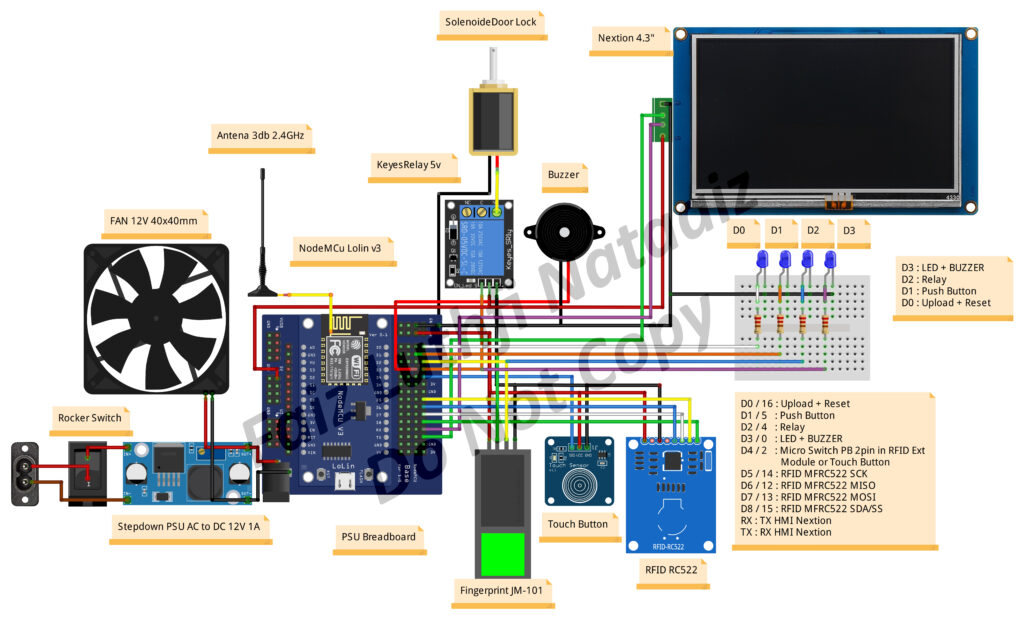
/* ---------------------------------------------------------------------------------------------------------------
* # File Name : Access Control v3
* # TA Project : Faiz Luthfi Nataiz
* # NIM : C1620201004
* # Judul TA : A Digital Security Door Lock System
* with RFID: Enhancing Student Card
* (KTM) Capability for Door Unlock and
* attendance Class based on IoT using
* NodeMCu 8266
* # Deskripsi : Perangkat elektronis yang digunakan untuk
* absensi dan buka tutup pintu menggunakan
* RFID dan fingerprint sensor. Dengan metode
* MQTT dan OTA serta dapat diakses secara
* localhost melalui penampil HMI touchscreen
* panel (nextion 4.3 inch).
*
* Software Requirement
* - Arduino IDE v1.8.10
* - nextion setup v1.62.1
* - xampp x63 v3.2.4 Compiled Jun 5th 2019
* -
* # Hardware Requirement
* - Input : RFID MFRC522 China Clone
* - Output : Nextion 4.3"
* - 3rd Platform : Google Firebase, Google Spreadsheet
* - Methode : OTA and MQTT
* - Aksesoris : 5pcs LED 5mm as Indicator & Buzzer
* : Relay Module 1 Ch
* : RTC and Micro SD Card
*
* # Feature alat :
* 1. brightness (https://www.youtube.com/watch?v=AuFZNkD2osg)
* 2. cek 4 led using hmi button (D0 ~ D8)
* 3. showing network data (ip address and subnet mask)
* 4. showing logbook record data RFID (absen hadir, pulang, istirahat/keluar)
* 5. showing data
*
* # Editor : Budhi Prayoga,ST,.M.Eng
* # Start Created : 09.04.2020
* # Last Update : 20.06.2021 | 18.06.2021 | 23.04.2021
* # Revisi : 4.0
* # Version : Beta
* # Platform :
* 1. Hardware : NodeMCu ESP8266 Lolin v3
* 2. Core Version :
* 3. Development Env : Arduino IDE 1.8.10
* 4. Operating System : Win 7 x64
* # Library Version
* 1. MFRC522 v1.4.4
* 2. ESP8266 v2.5.2
* 3.
* # Setting in IDE
* 1. Module : NodeMCu 1.0 (ESP-12E Module)
* 2. Upload Speed : 115200
* 3. CPU Frequency : 80MHz
* 4. Flash Size : 4M (No SPIFFS)
* 5. Debug Port : Disable
* 6. Debug Level : None
* 7. lwIP Variant : v2 Lower Memory
* 8. VTable : Flash
* 9. Exception : Disable
* 10.EraseFlash : Only Sketch
* 11.SSL Support : All SSL Chipher (more compatible)
* 12.Programmer : AVRISP mkII
*
* # Setting Preference in Arduino IDE
* File -> Preferences (Ctrl+Comma)
* 1. Show verbose output : Compilation (check) and upload (Check)
* 2. Display Line Number (Check)
* 3. Enable Code Folding (Check)
* 4. Additionals Board Manager Url
* https://dl.espressif.com/dl/package_esp32_index.json, http://arduino.esp8266.com/stable/package_esp8266com_index.json
* 5. Directory Preferences
* C:\Users\User\AppData\Local\Arduino15\preferences.txt
*
* # Location
* 1. Arduino : C:\Users\User\AppData\Local\Arduino15\packages\arduino\hardware\avr\1.8.3\libraries
* 2. ESP8266 : C:\Users\User\AppData\Local\Arduino15\packages\esp8266\hardware\esp8266
* ---------------------------------------------------------------------------------------------------------------
* # Tutorial
* > Watch Dog
* 0. WDT Timer Test Code Sample
* https://www.esp8266.com/viewtopic.php?p=57882#
* https://forum.makerforums.info/t/simple-watchdog-timer-a-simple-watchdog-timer-to-reset-the-esp8266-if-it-gets/56052/25
* 1. Soft WDT Reset NodeMCu ESP8266 (google keyword : soft wdt reset esp8266 lolin)
* https://forum.arduino.cc/index.php?topic=442570.0
* https://community.blynk.cc/t/soft-wdt-reset/38353/4 Core v2.4.2
* https://github.com/miguelbalboa/rfid/issues/267 ESP SDK 2.1 or 2.2 / add a delay between SPI.begin() and init
* 2. Theory (google keyword : watchdog esp8266 tutorial)
* https://www.sigmdel.ca/michel/program/esp8266/arduino/watchdogs_en.html
* https://portal.vidadesilicio.com.br/watchdog-esp8266/
* https://github.com/esp8266/Arduino/pull/2533/files
* https://www.embedded.com/introduction-to-watchdog-timers/
* https://bigdanzblog.wordpress.com/2019/10/08/watch-dog-timer-wdt-for-esp8266/
* https://techtutorialsx.com/2017/01/21/esp8266-watchdog-functions/
* 3. Disable WDT
* https://www.esp8266.com/viewtopic.php?f=13&t=20206
* 4. Reset Causes Boot Mode List
* https://www.esp8266.com/viewtopic.php?p=2096#p2112
* > RFID
* 1. What is RFID? How It Works? Interface RC522 RFID Module with Arduino
* https://lastminuteengineers.com/how-rfid-works-rc522-arduino-tutorial/
* https://circuits4you.com/2018/10/03/rfid-reader-rc522-interface-with-nodemcu-using-arduino-ide/
* https://www.hackster.io/mertarduino/access-control-system-everything-can-be-configured-via-web-1a4791
* > Nextion
* 1. Basic Program
* https://acoptex.com/project/7069/basics-project-081d-esp8266-esp-12e-module-and-nextion-hmi-display-at-acoptexcom/
* https://acoptex.com/project/7069/basics-project-081d-esp8266-esp-12e-module-and-nextion-hmi-display-at-acoptexcom/
* https://randomnerdtutorials.com/nextion-display-with-esp8266-touchscreen-user-interface-for-node-red/
* 2. Youtube
* NEXTION HMI DISPLAY WITH ARDUINO -Getting Started with LED ON/OFF
* https://www.youtube.com/watch?v=RbPfo8wW74I
* 3. Install USB to TTL
* http://saptaji.com/2018/01/15/cara-menginstal-driver-usb-to-ttl-converter-pl2303/
* https://berbageilmu.blogspot.com/2017/05/solusi-driver-usb-pl2303-tidak-bisa-di.html
* 4. Nextion TFT Touch Display Digital Clock v2.0 (Alarm Added) For NX4024K032_011 Nextion TFT
* https://www.youtube.com/watch?v=lOUyBH70O_w&t=0s
* GDrive : https://drive.google.com/drive/folders/1gAWsnSKJk_1CcJ7YAxWngYmkW97mF-_n
* 5. Cara Print Out WiFi.localIP() di nextion
* https://forum.arduino.cc/t/how-to-print-out-the-esp-local-ip-on-nextion-display/597931/4
* https://circuits4you.com/2019/03/16/esp8266-ip-to-string-conversion/
* > SDK & Demos Espressif System
* https://github.com/espruino/Espruino/issues/1207
* https://www.espressif.com/en/support/download/sdks-demos?keys=&field_type_tid%5B%5D=14
* > Access Control Config via WEB
* https://www.hackster.io/mertarduino/access-control-system-everything-can-be-configured-via-web-1a4791
* https://github.com/esprfid/esp-rfid/releases
* # Library
* > MRFC522 1.4.4 :
* > Nextion 4.3 : https://github.com/itead/ITEADLIB_Arduino_Nextion
* Make sure you edit the NexConfig.h file on the
* library folder to set the correct serial port for
* the display. By default it's set to Serial1, which
* most arduino boards don't have.
* Change "#define nexSerial Serial1" to "#define nexSerial Serial"
* # Catatan :
* > Methode
* 1. MQTT
* 2. OTA
* 3. xampp (web server apache dan database mysql
* CSS bootstrap, jquery, java script
*
* > Arduino Debugging
* 1. https://www.circuito.io/blog/arduino-debugging/
* 2. https://www.visualmicro.com/
* 3. https://visualstudio.microsoft.com/downloads/
* 4. https://docs.microsoft.com/en-us/visualstudio/releases/2019/system-requirements
* 5. https://www.visualmicro.com/page/User-Guide.aspx?doc=Debugging-Walkthrough-Start.html
* > Nextion Upload Data
* Baudrate : 115200
* Model : NX4827T043_011R(RTP)
* Firmware : S151
* Device Serial Number : D26670B15B253137
* CPUID : 61488
* Flash Size : 16777216(16MB)
* Address : 0
+-----------+
+-----------------------------------+ READ TAGS +-------------------------------------------+
| +--------------------+ |
| | | |
| +----v-----+ +-----v----+ |
| |MASTER TAG| |OTHER TAGS| |
| +--+-------+ ++-------------+ |
| | | | |
| +-----v---+ +----v----+ +----v------+ |
| +------------+READ TAGS+---+ |KNOWN TAG| |UNKNOWN TAG| |
| | +-+-------+ | +-----------+ +------------------+ |
| | | | | | |
| +----v-----+ +----v----+ +--v--------+ +-v----------+ +------v----+ |
| |MASTER TAG| |KNOWN TAG| |UNKNOWN TAG| |GRANT ACCESS| |DENY ACCESS| |
| +----------+ +---+-----+ +-----+-----+ +-----+------+ +-----+-----+ |
| | | | | |
| +----+ +----v------+ +--v---+ | +--------------->
+-------+EXIT| |DELETE FROM| |ADD TO| | |
+----+ | EEPROM | |EEPROM| | |
+-----------+ +------+ +-------------------------------+
Use a Master Card which is act as Programmer then you can able to choose card holders who will granted access or not
PIN |GPIO | Actual Pin | Status
static const uint8_t D0 = 16; 1 > D10 TX x dipakai LED 0 Indicator Upload + Reset
static const uint8_t D1 = 5; 2 > D4 + dipakai LED 1 Indicator Push Button when touched
static const uint8_t D2 = 4; 3 > D9 RX x dipakai LED 2 Indicator Relay ON/OFF
static const uint8_t D3 = 0; 4 > D2 dipakai LED 3 Indicator LED + BUZZER
static const uint8_t D4 = 2; 5 > D1 belum terpakai
static const uint8_t D5 = 14; 6 > x x tidak ada
static const uint8_t D6 = 12; 7 > x x tidak ada
static const uint8_t D7 = 13; 8 > x tidak ada
static const uint8_t D8 = 15; 9 > S2 + belum terpakai
static const uint8_t D9 RX = 3; 10 > S3 + belum terpakai
static const uint8_t D10 TX = 1; 11 > x x tidak ada
static const uint8_t S1 = MOSI 12 > D6 dipakai MFRC522 Biru SPI MISO
static const uint8_t S2 = 9 13 > D7 + dipakai MFRC522 Putih SPI MOSI
static const uint8_t S3 = 10 14 > D5 dipakai MFRC522 Kuning SPI SCK
15 > D8 + dipakai MFRC522 Hijau SPI SDA / SS Pin
16 > D0 + dipakai Buzzer
Typical pin layout used:
Source : https://github.com/miguelbalboa/rfid
* ---------------------------------------------------------------------------------------------------------------------
* MFRC522 NodeMCu Wemos D1 Mini Arduino Arduino Arduino Arduino Arduino
* Reader/PCD ESP8266 ESP9266 Mega Nano v3 Leonardo Pro Micro Uno
* Lolin v3 Uno 101 /Micro
* Signal Pin Pin GPIO Pin Pin Pin Pin Pin
* ---------------------------------------------------------------------------------------------------------------------
* RST/Reset RST D3 9 5 D9 RESET/ICSP-5 RST
* SPI SS SDA(SS) D8 (15) D8 10 53 D10 10 10
* SPI MOSI MOSI D7 (13) D7 11 / ICSP-4 51 D11 ICSP-4 16
* SPI MISO MISO D6 (12) D6 12 / ICSP-1 50 D12 ICSP-1 14
* SPI SCK SCK D5 (14) D5 13 / ICSP-3 52 D13 ICSP-3 15
* ---------------------------------------------------------------------------------------------------------------------
*/
//inisialisasi pin RFID MFRC522
#define SS_PIN 15 //D2
#define RST_PIN 10 //S3
#include "Nextion.h"
//#include <Nextion.h>
#include <SPI.h>
#include <MFRC522.h>
#include <ESP8266HTTPClient.h>
#include <ESP8266WiFi.h>
MFRC522 mfrc522(SS_PIN, RST_PIN); // Create MFRC522 instance.
int statuss = 0;
int out = 0;
const int led0 = 16; //D0 GPIO16 Indicator Upload + Reset
const int ledPB = 5; //D1 GPIO05 Indicator Push Button / Touch Button when pressed
const int relay = 4; //D2 GPIO04 Relay
const int buzzer = 0; //D3 GIPO 0 LED + Buzzer
const int btn = 2; //D4 Micro Switch Push Button 2 pin in RFID Ext Module
//Network SSID
const char* ssid = "Budhi_Prayoga";
const char* password = "Yukihiro280588!";
//const char* ssid = "LAB_TE";
//const char* password = "innovation";
//pengenal host (server) = IP Address komputer server
const char* host = "192.168.100.20";
//Declare your Nextion objects , pageid, component id., component name
//Declare objects that we are going to read from the display. This includes buttons, sliders, text boxes, etc:
//Format: <type of object> <object name> = <type of object>(<page id>, <object id>, "<object name>");
/* ***** Types of objects:
* NexButton - Button
* NexDSButton - Dual-state Button
* NexHotspot - Hotspot, that is like an invisible button
* NexCheckbox - Checkbox
* NexRadio - "Radio" checkbox, that it's exactly like the checkbox but with a rounded shape
* NexSlider - Slider
* NexGauge - Gauge
* NexProgressBar - Progress Bar
* NexText - Text box
* NexScrolltext - Scroll text box
* NexNumber - Number box
* NexVariable - Variable inside the nextion display
* NexPage - Page touch event
* NexGpio - To use the Expansion Board add-on for Enhanced Nextion displays
* NexRtc - To use the real time clock for Enhanced Nextion displays
* *****
*/
/* ID Halaman, ID Objek, Nama Objek
* ---------------------------------
*
*/
// (page, id, "objname");
NexButton b0 = NexButton(3,7,"b0");
NexButton b1 = NexButton(3,8,"b1");
NexText t0 = NexText(3,9,"t0");
NexText t1 = NexText(3,12,"t1");
NexNumber n0 = NexNumber(3, 11, "n0"); //ip address
String IPaddress;
int counter = 1;
int btnState = 0;
//Register a button object to the touch event list
//Format: &<object name>,
NexTouch *nex_listen_list[] = {
&b0, //button on
&b1, //button off
&n0, //number of ip address
&t1, //text of ip address
//void MIFARE(),
NULL //String terminated
};
void setup(void) {
Serial.begin(115200);
SPI.begin(); // Initiate SPI bus
mfrc522.PCD_Init(); // Initiate MFRC522
//Start inisialisasi koneksi WiFi
WiFi.hostname("NodeMCU_Koko");
WiFi.begin(ssid, password);
//cek koneksi wifi
while(WiFi.status() != WL_CONNECTED)
{
//progress sedang mencari WiFi
delay(500);
Serial.print(".");
}
Serial.println("");
Serial.println("Wifi Connected");
Serial.print("IP Address : ");
Serial.println(WiFi.localIP());
//end inisialisasi koneksi WiFi
Serial.println("ready");
Serial.println("Initial Check LED Condition");
delay(150);
// inisialisasi pin input
pinMode(btn, INPUT); //D4 Micro Switch Push Button 2 pin in RFID Ext Module
//inisialisasi pin output
pinMode(led0,OUTPUT); //D0 GPIO16 Indicator Upload + Reset
pinMode(ledPB,OUTPUT); //D1 GPIO05 Indicator Push Button / Touch Button when pressed
pinMode(relay,OUTPUT); //D2 GPIO04 Relay
pinMode(buzzer,OUTPUT); //D3 GIPO 0 LED + Buzzer
//
digitalWrite(led0,HIGH);
digitalWrite(ledPB,HIGH);
digitalWrite(relay,HIGH);
digitalWrite(buzzer,HIGH);
delay(2000);
digitalWrite(led0,LOW);
digitalWrite(ledPB,LOW);
digitalWrite(relay,LOW);
digitalWrite(buzzer,LOW);
Serial.println("LED Check Finish");
delay(500);
//nexInit();
//Register the pop event callback function of the components
//b0.attachPop(b0PushCallback,&b0);
//b1.attachPop(b1PushCallback,&b1);
b0.attachPop(b0PopCallback,&b0);
b1.attachPop(b1PopCallback,&b1);
//n0.attachPop(n0PopCallback,&n0);
//t1.attachPop(t1PopCallback,&t1);
Serial.println("Dekatkan Kartu RFID Anda ke Reader");
Serial.println();
}
void loop() {
//nexLoop(nex_listen_list); // Check for any touch event
//delay(150); //for stability
//void MIFARE();
//Look for new cards
btnState = digitalRead(btn);
// check if the pushbutton is pressed. If it is, the buttonState is HIGH:
if (btnState == LOW) {
// turn LED on:
Serial.println("");
Serial.println("HIGH");
digitalWrite(ledPB,HIGH);
digitalWrite(relay,HIGH);
digitalWrite(buzzer,HIGH);
delay(150);
} else {
// turn LED off:
digitalWrite(ledPB,LOW);
digitalWrite(relay,LOW);
digitalWrite(buzzer,LOW);
delay(150);
}
int timeDelay = 10;
while(timeDelay > 0)
{
if ( ! mfrc522.PICC_IsNewCardPresent()){
return;
}
// Select one of the cards
if ( ! mfrc522.PICC_ReadCardSerial()){
return;
}
//Show UID on serial monitor
Serial.println();
Serial.print(" UID tag :");
String content= "";
byte letter;
for (byte i = 0; i < mfrc522.uid.size; i++){
Serial.print(mfrc522.uid.uidByte[i] < 0x10 ? " 0" : " ");
Serial.print(mfrc522.uid.uidByte[i], HEX);
content.concat(String(mfrc522.uid.uidByte[i] < 0x10 ? " 0" : " "));
content.concat(String(mfrc522.uid.uidByte[i], HEX));
}
content.toUpperCase();
Serial.println();
if (content.substring(1) == "2D C7 E0 AF") //change UID of the card that you want to give access
{
Serial.println("t1.setText=" + String(mfrc522.uid.uidByte, HEX));
//t1.setText("UID Card: 2DC7E0AF");
Serial.println("");
Serial.println(" Access Granted ");
digitalWrite(buzzer,HIGH);
delay(500);
digitalWrite(buzzer,LOW);
Serial.println();
t1.setText("UID Card: 2DC7E0AF");
statuss = 1;
//Serial.println("n0.val=2D C7 E0 AF");
//Serial.print("n0.val=" + String(counter));
//Serial.println("t1.txt=2D C7 E0 AF");
//t1.setText("UID Card: 2DC7E0AF");
//Serial.print("t0.txt=" + String(IPaddress));
//Serial.write(0xff);
//Serial.write(0xff);
//Serial.write(0xff);
counter++;
}
else{
Serial.println(" Access Denied ");
buzz();
}
delay(150);
}
}
void buzz(){
for (int a=0; a<6; a++)
{
digitalWrite(buzzer,HIGH);
delay(50);
digitalWrite(buzzer,LOW);
delay(50);
}
}
void MIFARE(){
//nexLoop(nex_listen_list);
//Look for new cards
/*if ( ! mfrc522.PICC_IsNewCardPresent())
{
return;
}
// Select one of the cards
if ( ! mfrc522.PICC_ReadCardSerial())
{
return;
}
//Show UID on serial monitor
Serial.println();
Serial.print(" UID tag :");
String content= "";
byte letter;
for (byte i = 0; i < mfrc522.uid.size; i++)
{
Serial.print(mfrc522.uid.uidByte[i] < 0x10 ? " 0" : " ");
Serial.print(mfrc522.uid.uidByte[i], HEX);
content.concat(String(mfrc522.uid.uidByte[i] < 0x10 ? " 0" : " "));
content.concat(String(mfrc522.uid.uidByte[i], HEX));
}
content.toUpperCase();
Serial.println();
if (content.substring(1) == "2D C7 E0 AF") //change UID of the card that you want to give access
{
Serial.println(" Access Granted ");
digitalWrite(led3,HIGH);
delay(1000);
digitalWrite(led3,LOW);
Serial.println();
statuss = 1;
}
else{
Serial.println(" Access Denied ");
digitalWrite(led3,LOW);
delay(1000);
}*/
}
//Button b0 component popcallback function
//When ON button is Released the LED turns ON and the state text changes
//void b0PushCallback(void *ptr) // Press event for button b1
/*void b0PushCallback(void *ptr) // push event for button b0
{
//t0.setText ("Status: ON");
digitalWrite(led,HIGH);
Serial.println("LED ON");
Serial.println("b0PushCallback");
}
void b1PushCallback(void *ptr) // push event for button b0
{
//t0.setText ("Status: ON");
digitalWrite(led, LOW);
Serial.println("LED OFF");
Serial.println("b1PushCallback");
}*/
void b0PopCallback(void *ptr){ // Release event for button b0
//t0.setText ("Status: ON");
digitalWrite(led0,HIGH);
digitalWrite(ledPB,HIGH);
digitalWrite(relay,HIGH);
digitalWrite(buzzer,HIGH);
Serial.println("LED ON");
Serial.println("b0PopCallback");
}
//Button b1 component popcallback function
// When OFF button is released the LED turns OFF and the state text changes
void b1PopCallback(void *ptr){ // Release event for button b1
//void b1PushCallback(void *ptr) // Release event for button b1
//t0.setText ("Status: OFF");
digitalWrite(led0,LOW);
digitalWrite(ledPB,LOW);
digitalWrite(relay,LOW);
digitalWrite(buzzer,LOW);
Serial.println("LED OFF");
Serial.println("b1PopCallback");
}
/*void n0PopCallback(void *ptr){
//IPaddress = WiFi.localIP().toString();
//n0.setValue(WiFi.localIP());
//Serial.println("n0.val=" + String(IPaddress));
//dbSerialPrintln("n0PopCallback");
//n0.setValue(50);
//Serial.print("n0.val=2D C7 E0 AF");
//Serial.print("t1.txt=2D C7 E0 AF");
//Serial.write(0xff);
//Serial.write(0xff);
//Serial.write(0xff);
}
void t1PopCallback(void *ptr){
//Serial.print("n0.val=2D C7 E0 AF");
//Serial.print("t1.txt=2D C7 E0 AF");
//Serial.write(0xff);
//Serial.write(0xff);
//Serial.write(0xff);
//t1.setText(WiFi.localIP());
//Serial.println("t1.setText=" + String(IPaddress));
//dbSerialPrintln("n0PopCallback");
//n0.setValue(50);
}*/
4. Galeri
5. Video Demo
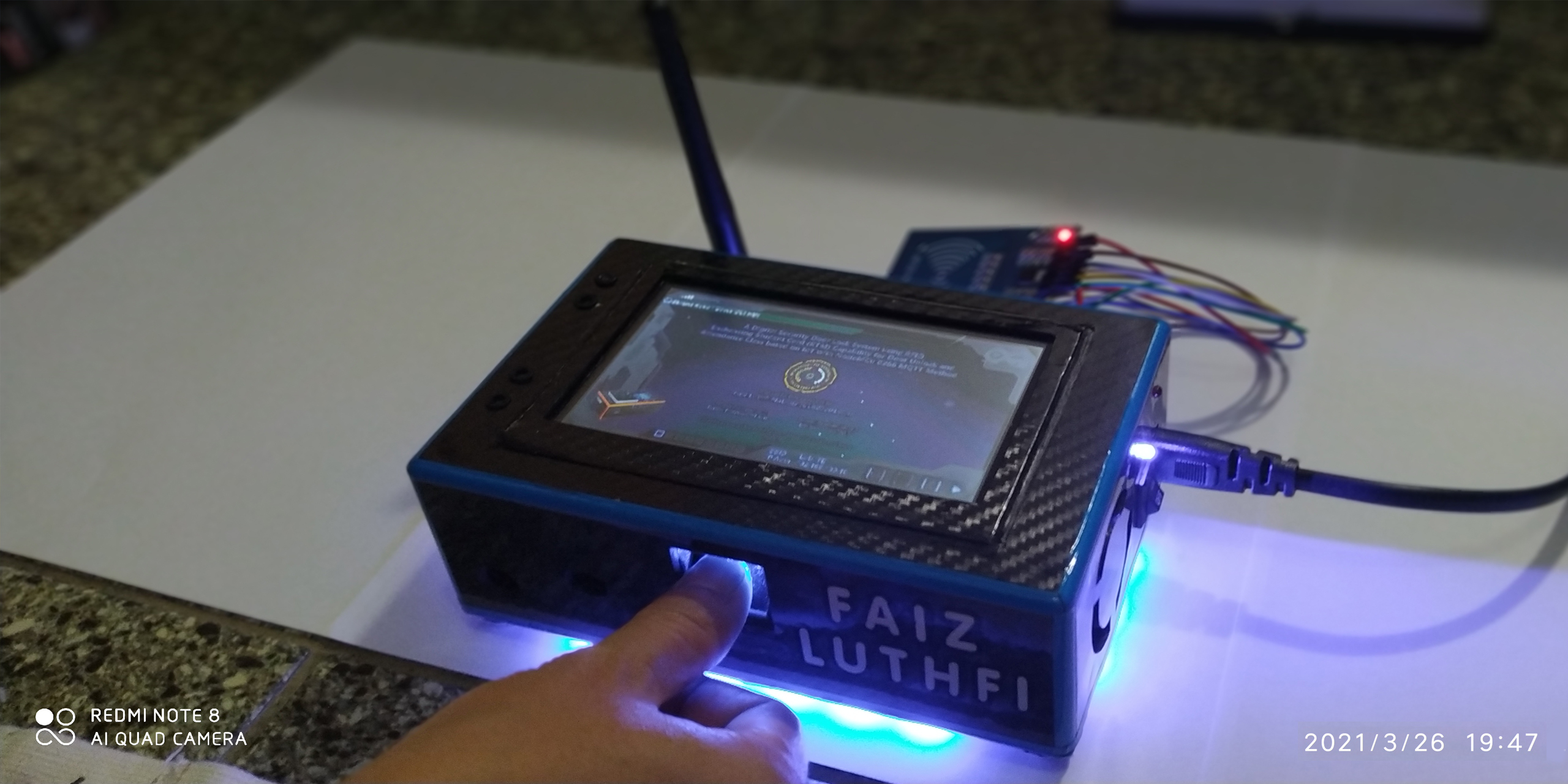





 Visit Today : 49
Visit Today : 49 Visit Yesterday : 61
Visit Yesterday : 61 This Month : 1328
This Month : 1328 This Year : 8281
This Year : 8281 Total Visit : 39972
Total Visit : 39972 Hits Today : 49
Hits Today : 49 Total Hits : 34156
Total Hits : 34156 Who's Online : 23
Who's Online : 23